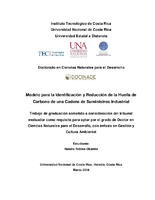Modelo para la Identificación y Reducción de la Huella de Carbono de una Cadena de Suministros Industrial
Abstract
The increment of greenhouse gases is the main cause of climate change. Worldwide regulatory pressure regarding their emission has been increasing in late years. Though Costa Rica is not a significant emitter, it is seeking, as other countries, to reduce them, and in fact, is committed to become a carbon-neutral country in the near future. This research was conducted to develop a mathematical model aimed to identify and reduce carbon emissions in supply chain management.
The structure of the supply chain network in this research included suppliers, plants, warehouses and retailers. The carbon emissions related to each of the activities involved were calculated by means of carbon emission factors and through global warming factors they were converted into carbon equivalent emissions. The model determines a supply chain network that minimizes the impact of the carbon footprint and its total cost. In addition, the designed model achieves a supply chain network that minimizes total costs under a carbon limit. Moreover, the proposed model can determine the supply chain network that minimizes a combined function of emissions and operational costs. Furthermore, it finds a network model that comes closer to reach certain desired environmental and economical target values. A network optimization mathematical model solved by mix integer linear programming was developed to meet these requirements.
The application of the model to the supply chain case of a manufactured product, showed this proposed model could be used to obtain an insight of the differences and similarities between supply chain networks when costs and carbon emissions are optimized in parallel. Most importantly, the model determines the network that accomplishes a reasonable agreement between the emissions and cost objectives, that is, a network with fewer carbon emissions at a low-cost increment. This research
xi
also found that when economic objectives prevail over environmental objectives, carbon emission reduction becomes difficult. Hence, the model makes a significant contribution to the body of research in understanding the importance of the carbon footprint in the supply chain network. Therefore, the model hereby designed, is useful for both manufacturing enterprises and sustainable development policy makers. In addition, the model is versatile, and it can be applied to several product supply chains, as long as they have an analogous network.
Climate change projections and future scenarios reveal it will severely harm society and economy. Despite the search for alternative energy sources, clean and renewable, fossil fuel dependency will prevail in the short and midterm future. Therefore, tackling the problem of reducing greenhouse gases emissions is necessary on behalf of the entire world population. The proposed model encourages corporate social responsibility, due to the economic and environmental impact information it provides for decision making in supply chain network management. Even more, the potential carbon reduction emissions from this model have important environmental, social and economic benefits.


